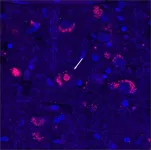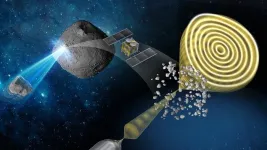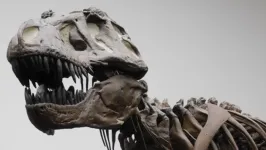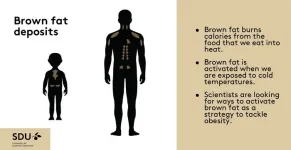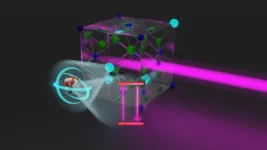(Press-News.org) As embryos, all complex organisms are partially made up of pluripotent stem cells, a term for cells that have the capacity to differentiate into any kind of cell: nerve cells, muscle cells, blood cells, skin cells, and the like. As the ultimate biological “shape-shifters,” these cells are proving key to regenerative medicine, drug development, genetic research, and related fields.
Within a pluripotent stem cell, certain genes get activated and express information that ultimately decides a cell’s fate. The first step in this expression process is called transcription, a process that turns out to be incredibly complex, in part because each cell contains thousands of genes and only a portion are utilized at any given time.
And, it should be complex, according to Sharon Torigoe, assistant professor of biology, and a molecular biologist, who studies how transcription is controlled
“It shouldn't be easy to derail any of these processes, right?” says Professor Torigoe. “They’ve been perfecting themselves over the millennia to have the most selectively advantageous system.”
Torigoe is investigating a small part of these complicated systems. Her work was recently recognized by the National Science Foundation (NSF) with a three-year Research in Undergraduate Institutions (RUI) grant. The grant is from NSF’s Molecular and Cellular Biosciences (MCB) program’s Genetic Mechanisms Cluster, which funds inventive ideas and research to address fundamental questions about genetics, epigenetics, and gene expression mechanisms. Torigoe’s grant will support work she leads with Lewis & Clark College undergraduate students to unlock the mechanisms behind what determines a pluripotent cell’s fate. A better understanding of these mechanisms is key to unlocking the potential of regenerative medicine.
Throughout the three-year grant period, the NSF funding will support at least seven students participating in full-time summer research experiences through the Rogers Science Research Program, a signature summer research program at Lewis & Clark College.
Taking it gene by gene
Torigoe is specifically focused on understanding enhancers. Enhancers are genomic sequences that serve as binding sites for proteins that control transcription. These sequences exist some distance away from the part of the genome where transcription takes place. But enhancers are important because they increase the likelihood that transcription of a certain gene will occur.
While some scientists learn about the rules of gene expression by studying thousands of genes simultaneously through machine learning, Torigoe’s approach is to examine one or two individual genes at a time.
“There could be a number of rules involved in what makes an enhancer function the way it does,” says Torigoe. “This diversity among enhancers is what makes it exciting. The diversity also makes it very daunting.”
Torigoe and her students use the embryonic stem cells of mice to investigate Klf4, an enhancer that is crucial for maintaining a cell’s pluripotency. Enhancer grammar, or its characteristics, are thought to be key to its function.
Scientists studying enhancers refer to their characteristics as grammar because, according to Torigoe, an enhancer’s protein binding sites could be likened to individual words. A series of binding sites are like a sentence built on multiple words that, when strung together, create meaning.
One thing Torigoe is looking for is what characteristics lead a protein to have affinity for a particular enhancer sequence.
“For example, can the protein ‘read’ the binding site as correct, even if there are ‘typos?’” she asks. “And then there's syntax, or the order the words are in. If the subject and object are reversed, or the verb is in a different place, that can change the meaning of the sentence and, therefore, the function of the enhancer.”
Torigoe says her students sometimes find the complicated nature of investigating enhancer grammar frustrating because there is usually not a simple answer or explanation to their questions.
“Different parts of enhancer grammar interact, making it a challenge to study,” she says. “When we think we have answered one question, we realize there are 10 new questions.”
Still, Torigoe hopes to make headway on unlocking the mechanisms that govern the functioning of enhancer genes, like Klf4, and then apply that knowledge to other genes.
“I have to go after one gene,” she says. “And then after that one, maybe I can go after some more genes. And then we might discover that this one rule applies to 10 other genes. Then, there may be another 2,000 genes that do something else, so then we can investigate those.”
She adds: “In the end, enhancer grammar is probably going to be complicated because biology is ultimately very complicated.
END
Decoding cellular ‘shape-shifters’
Biologist Sharon Torigoe and her students investigate the mechanisms that determine a cell’s fate.
2024-04-29
ELSE PRESS RELEASES FROM THIS DATE:
"Seeing the invisible": new tech enables deep tissue imaging during surgery
2024-04-29
Hyperspectral imaging (HSI) is a state-of-the-art technique that captures and processes information across a given electromagnetic spectrum. Unlike traditional imaging techniques that capture light intensity at specific wavelengths, HSI collects a full spectrum at each pixel in an image. This rich spectral data enables the distinction between different materials and substances based on their unique spectral signatures. Near-infrared hyperspectral imaging (NIR-HSI) has attracted significant attention in the food and industrial fields ...
After 25 years, researchers uncover genetic cause of rare neurological disease
2024-04-29
**EMBARGOED BY NATURE GENETICS UNTIL 10AM BST/ 5AM ET/ 3AM MT, APRIL 29**
Some families call it a trial of faith. Others just call it a curse. The progressive neurological disease known as spinocerebellar ataxia 4 (SCA4) is a rare condition, but its effects on patients and their families can be severe. For most people, the first sign is difficulty walking and balancing, which gets worse as time progresses. The symptoms usually start in a person’s forties or fifties but can begin as early as the late teens. There is ...
Probing the effects of interplanetary space on asteroid Ryugu
2024-04-29
Samples reveal evidence of changes experienced by the surface of asteroid Ryugu, some probably due to micrometeoroid bombardment.
Analyzing samples retrieved from the asteroid Ryugu by the Japanese Space Agency’s Hayabusa2 spacecraft has revealed new insights into the magnetic and physical bombardment environment of interplanetary space. The results of the study, carried out by Professor Yuki Kimura at Hokkaido University and co-workers at 13 other institutions in Japan, are published in the journal Nature Communications.
The investigations used electron waves penetrating ...
T. rex not as smart as previously claimed, scientists find
2024-04-29
Dinosaurs were as smart as reptiles but not as intelligent as monkeys, as former research suggests.
An international team of palaeontologists, behavioural scientists and neurologists have re-examined brain size and structure in dinosaurs and concluded they behaved more like crocodiles and lizards.
In a study published last year, it was claimed that dinosaurs like T. rex had an exceptionally high number of neurons and were substantially more intelligent than assumed. It was claimed that these high neuron counts could directly inform on ...
Breakthrough in brown fat research: Researchers from Denmark and Germany have found brown fat’s “off-switch”
2024-04-29
Brown fat, also known as brown adipose tissue (BAT), is a type of fat in our bodies that's different from the white fat around our belly and thighs that we are more familiar with. Brown fat has a special job—it helps to burn calories from the foods that we eat into heat, which can be helpful, especially when we're exposed to cold temperatures like during winter swimming or cryotherapy. For a long time, scientists thought that only small animals like mice and newborns had brown fat. But new research shows that a certain number of adults maintain their brown fat throughout life. Because brown fat is so good at burning calories, scientists ...
Tech Extension Co. and Tech Extension Taiwan to build next-generation 3D integration manufacturing lines using Tokyo Tech's BBCube Technology
2024-04-29
Tech Extension Co., Ltd. (referred to hereinafter as TEX)[1] and Tech Extension Taiwan Co., Ltd. (referred to hereinafter as TEX-T)[2] have agreed with Innolux Corporation (referred to hereinafter as INNOLUX)[3] to build in a cleanroom of INNOLUX a manufacturing line intended for next-generation 3D integration[4] based on the Bumpless Build Cube (BBCube[5]), which is a technology achieved through the Tokyo Institute of Technology WOW Alliance[6].
TEX will transfer WOW technology[7] and COW technology[8], which are both based on the BBCube technology platform, to this manufacturing line intended for next-generation 3D integration. ...
Atomic nucleus excited with laser: a breakthrough after decades
2024-04-29
Physicists have been hoping for this moment for a long time: for many years, scientists all around the world have been searching for a very specific state of thorium atomic nuclei that promises revolutionary technological applications. It could be used, for example, to build an nuclear clock that could measure time more precisely than the best atomic clocks available today. It could also be used to answer completely new fundamental questions in physics - for example, the question of whether the constants of nature are actually constant or whether they change in space ...
Losing keys and everyday items ‘not always sign of poor memory’
2024-04-29
The mysteries of how memory works are explained in a new book that suggests anyone can boost their powers of recall – and that losing your keys is normal.
Dr Megan Sumeracki and Dr Althea Need Kaminske say storing and retrieving information is far more complex than people think. Extremes of memory such as photographic or savant are also very rare despite their regular portrayal in films.
Their new book The Psychology of Memory outlines simple recollection-boosting techniques to improve learning – or to help remember names and numbers.
Forgetting is normal
The authors highlight how a degree ...
People with opioid use disorder less likely to receive palliative care at end of life
2024-04-29
Compared with people without opioid use disorder, those with opioid use disorder were less likely to receive palliative care in clinics and in their homes, and were dying at younger ages of causes other than opioid use, according to new research published in CMAJ (Canadian Medical Association Journal) https://www.cmaj.ca/lookup/doi/10.1503/cmaj.231419.
“The majority of conversations about the opioid crisis focus on the high number of opioid toxicity deaths. The unfortunate reality is that people with opioid use disorder ...
New Durham University study reveals mystery of decaying exoplanet orbits
2024-04-29
-With images-
A new study led by researchers at Durham University has uncovered a novel mechanism that could solve a long-standing mystery about decaying planetary orbits around stars like our Sun.
The study, published in The Astrophysical Journal Letters, proposes that stellar magnetic fields play a crucial role in dissipating the gravitational tides responsible for the orbital decay of ‘hot Jupiter’ exoplanets.
Hot Jupiters are massive, gaseous planets similar to Jupiter that orbit extraordinarily close to their parent stars, taking only a few days to complete ...
LAST 30 PRESS RELEASES:
Numbers in our sights affect how we perceive space
SIMJ announces global collaborative book project in commemoration of its 75th anniversary
Air pollution exposure and birth weight
Obstructive sleep apnea risk and mental health conditions among older adults
How talking slows eye movements behind the wheel
The Ceramic Society of Japan’s Oxoate Ceramics Research Association launches new international book project
Heart-brain connection: international study reveals the role of the vagus nerve in keeping the heart young
Researchers identify Rb1 as a predictive biomarker for a new therapeutic strategy in some breast cancers
Survey reveals ethical gaps slowing AI adoption in pediatric surgery
Stimulant ADHD medications work differently than thought
AI overestimates how smart people are, according to HSE economists
HSE researchers create genome-wide map of quadruplexes
Scientists boost cell "powerhouses" to burn more calories
Automatic label checking: The missing step in making reliable medical AI
Low daily alcohol intake linked to 50% heightened mouth cancer risk in India
American Meteorological Society announces Rick Spinrad as 2026 President-Elect
Biomass-based carbon capture spotlighted in newly released global climate webinar recording
Illuminating invisible nano pollutants: advanced bioimaging tracks the full journey of emerging nanoscale contaminants in living systems
How does age affect recovery from spinal cord injury?
Novel AI tool offers prognosis for patients with head and neck cancer
Fathers’ microplastic exposure tied to their children’s metabolic problems
Research validates laboratory model for studying high-grade serous ovarian cancer
SIR 2026 delivers transformative breakthroughs in minimally invasive medicine to improve patient care
Stem Cell Reports most downloaded papers of 2025 highlight the breadth and impact of stem cell research
Oxford-led study estimates NHS spends around 3% of its primary and secondary care budget on the health impacts of heat and cold in England
A researcher’s long quest leads to a smart composite breakthrough
Urban wild bees act as “microbial sensors” of city health.
New study finds where you live affects recovery after a hip fracture
Forecasting the impact of fully automated vehicle adoption on US road traffic injuries
Alcohol-related hospitalizations from 2016 to 2022
[Press-News.org] Decoding cellular ‘shape-shifters’Biologist Sharon Torigoe and her students investigate the mechanisms that determine a cell’s fate.



